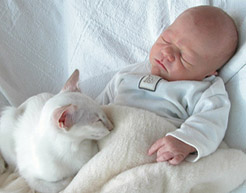

home our cattery girls boys news litters articles gallery links
| I got my first cat, a Siamese, in 1973 and have been passionate about these animals ever since.
Then, in 1988, I fall in love with the long-haired siamese and started breeding Balinese cats under the prefix of blue Moon.
I am a biologist, specialized on the behaviour of cats. also went on to become involved with the animals on a vocational level My PhD under the supervision of the well-known cat expert Dr. Dennis Turner, analysed the various housing conditions and the stress levels of cats in animal shelters. Nowadays, however, I enjoy cats just as my hobby. Breeding Aims It is my aim to continuously improve the Balinese type (without creating a too extreme type) whilst maintaining the distinctive character and health of this particular breed. In the early years I have concentrated on the American Balinese for a number of years. The Purrmatix and Tassam lines in particular possessed the elegance and refinement that I wanted to achieve in my breeding. Today, after more than 25 years of breeding, I mainly intend to further cross my carefully developed balinese lines with some excellent European Siamese cats, carrying the longhair gen, in order to further stabilize the beauty and health of the breed. Important imports in our breeding history Responsibility Breeding demands a good knowledge of the lines, the biology and the behaviour of the animals. Furthermore, rather than fulfilling high breeding ambitions, it is important to make decisions with having always the cats well-being in mind. Those that do so have my utmost respect. Character and health are important aspects. Many breeders are convinced that their animals are particularly healthy and strong characters. I believe, if we want things to stay that way, it is not only essential that we avoid inbreeding and keep the animals in adequate living conditions, but also it is important that we do not use animals with physical and behavioral problems for breeding. Quality Instead of Quantity A group of cats living together in harmony is a wonderful thing and orientals are usually very social cats. However, the more animals that are in a group, the more likely it is that tensions will arise between individuals. This is why we breed on a small scale. This also means that animals, with which we are no longer actively breeding are generally given to good homes. While it is always painful to have to say goodbye to a cat, it is in my opinion the best thing for the animal. In a loving family, the cat is the centre of attention and its individual personality can unfold (and cats are great individualists!). The cat receives the affection and space that it needs, without having to be a successful show or breeding cat. Life in a large group of cats, where the breeder is unable to part from any of his animals, can be extremely stressful in the long-term, especially if the cats don1ò4t have much space. My Wishes to Future Owners and Breeders To give the animals a great deal of love and respect and show understanding for the cat as an individual. To accept and integrate the animal as a full member of the family and give it the respect and care that these animals deserve. Furthermore, I hope that new breeders have the patience to build up the breed slowly and pay great attention to the breeding lines. To my regret, I have to turn down a lot of requests as I do only few litters. A Note of Thanks... I would like to thank the following people in particular for their friendship and support of my passion for Balinese cats: |

Mirjam with By-Aristotle Ray of Light  Livius the most successful boy I have bred so far with one of his kittens  Mer du Sud with our 5 days old son Nicholas  each cat wants to be respected as an individual personality  My husband Harald with Livius Verus of blue Moon |